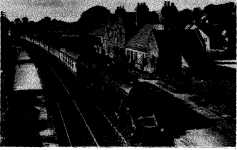
|
In 1850 a railway line following the Lune-Wenning valley and constructed from Morecambe to Skipton by the 'Little' North Western Railway linked up with the Leeds-Bradford Railway's line to Skipton to provide the first through rail service between the cities of the West Riding and the emergent West Coast seaside resort. Since then traffic between the two has never been less than brisk, and the railway has been a vital factor in the creation and development of the rural communities in between. How vital it has been is often forgotten in this car-minded age; Hellifield, for example, like Carnforth, is a creation of the railway; the development of most of the communities along the line would have been significantly retarded without the railway's presence. As ownership of the line passed in turn to the Midland Railway, the London, Midland and Scottish Railway, and, finally, British Rail, certain aspects of the line's use and economy have changed. Stations that now sound tremendously useful (Wray, Claughton, Low Bentham, Settle Junction) were closed quite early on in the line's history. During the 'Beeching' era the direct route along the Lune Valley from Wennington through Hornby and Caton to Lancaster was lost (in 1966). Many stations on that stretch and others such as Bell Busk for Malham and those on the Wennington-Carnforth section had already been lost in the 50's, as had the Ingleton-Kirkby Lonsdale-Sedbergh-Low Gill branch. The branches from Hellifield to Blackburn and from Skipton to Burnley through Earby and Colne were also lost in the early 60's, (although there is now some prospect of the restoration and full reopening of the Hellifield-Blackburn line over the next few years). In spite of all these threatening prunings, however, the line continued, with a service of approximately 7 trains per day in each direction at roughly two-hour intervals, to maintain links between West Yorkshire and Morecambe and enabled the people of the rural communities of Craven and Lunesdale in between to avail themselves of work, education and leisure opportunities. In 1989 at the beginning of the present economic recession, when the government was cutting back even more fiercely on public spending, there was a feeling that the line might be threatened with, if not closure, at least severe cuts, and the Railway Development Society urged local users of the line to form a group to work for the maintenance of services. The Lancaster and Skipton Rail User Group (LASRUG) was duly formed. Sure enough the cuts came; further reductions with each new BR timetable. In May 1990 the service was reduced to 5 trains per day each way (i.e. one every 3 hours) and in July 1991 that was further reduced to 4 trains per day each way (i.e. one every 4 hours). This amounts to a 43% cut in 14 months. Concern about the cuts has been expressed at local, district and county level and by the rail users' watchdogs, the Transport Consultative Committees for the North West and the North East of England Recently that concern has led to the formation of a Joint Action Group consisting of representatives of the Lancashire and North Yorkshire County Councils, the TUCC, LASRUGG and other interested bodies (The Countryside Commission, the Ramblers Association, the YHA, Friends of Settle-Carlisle etc.). This group is beginning to further its case by doing surveys to establish the extent of use and the potential market, in order to challenge BR's oft-repeated but poorly substantiated claim that the line is a low earner. In addition it will aim to promote use of the line to ensure not only its survival but also the restoration of the much better service enjoyed until May 1990. As a result of recent meetings with BR representatives, British Rail is prepared to offer some promotion on the line (one before and one after Christmas) to see how much use can be encouraged from stations between Wennington and Gargrave. If those who live on the line use it to show that they wish to retain a rail link for their communities, BR maintain that they will respond positively for their part with an improved service. User and Action groups can play their part but ultimately the communities must play theirs by using the line and encouraging one another to be more prepared to think rail instead of car, or, when predictions based on the recent trans-pennine transport survey become a reality and the A65 is as chock-a-block as the M25, there will be no alternative to turn to, no heritage to inherit. The Chairman of the Lancaster and Skipton Railway Joint Action Group is: Councillor Ralph Atkinson, Lower Streakber, Robin Lane, High Bentham, Lancaster. The Chairman of the Lancaster and Skipton Rail User Group is: Mr J S. Warbrick, Lakeber House, Robin Lane, High Bentham, Lancaster. LA2 7A |
